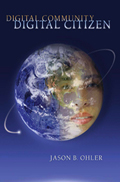After you're blogged, twittered and flattened
And are ready to jump into the fray
You're still left with the age-old question
Just what was it you wanted to say?
If I had to sum up the digital age in education in one sentence it would be: Finally, we all get to tell our own stories in our way using the tools that best suit how we learn, create and communicate.

Given the variety of tools and modes of expression available to us, just what is it we want to say? Let me look at this through some of my activities during just the past few weeks, which found me in a number of classrooms working with students and teachers in new media narrative projects. These projects are very typical:
- Fifth graders at Klukwan elementary, in Klukwan, Alaska. The students created "conversation stories" between themselves and someone else from a different culture they had been studying in order to develop a deeper understanding of themselves and their place in "the global village. "
- Third graders at Joy Elementary school in Fairbanks, Alaska. This is part of an NSF grant to combine exploration of the impacts of climate change and digital storytelling. The goal is to combine the power of story and critical thinking into an integrated approach to learning and expression.
- Language apprentices at the Klukwan Community Center. The focus of their project is to give digital voice to their efforts to preserve their native language, Tlingit, which currently has a life expectancy of ten to twenty years.
In each case, students used either iMovie or MovieMaker (roughly iMovie's equivalent on the PC) to combine recorded voice, original artwork and photographs into an origin
 al authentic narrative. Students reflected, wrote, recorded, listened, rewrote, and re-recorded until their narrative was synthesized, clear, and compelling. Then they added images that helped tell their story.
al authentic narrative. Students reflected, wrote, recorded, listened, rewrote, and re-recorded until their narrative was synthesized, clear, and compelling. Then they added images that helped tell their story.Something magical happens when students listen to their writing, rather than just reading it. They hear things they just can't hear through the typical writing process. And they modify things they wouldn't have otherwise.
So, what did all of these students have to say? Beyond the details, which always vary widely from one project to the next, students all said basically this: I have a voice, and a story to tell, about the land, my culture, myself and my hopes and concerns for the future. My story is based on what I learn through observation, study, participation and reflection. And I am telling my story using a language that is important to me, the language of new media, so that others might understand what I see.
As always, more at: jasonohler.com/storytelling and, jasonohler.com/beyondessays.






